Why Bother Being Nice?
This week, we’re asking "would you risk your life to save someone else?". Plenty of people do, and so do other animals and even bacteria. But why? And how did altruistic actions like this evolve? Plus in the news, scientists clone monkeys, the modified cold virus that selectively attacks pancreatic cancer, and why bees might be bad for other pollinators.
In this episode
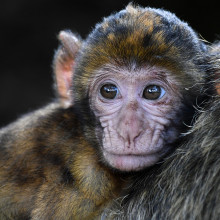
00:59 - Scientists clone monkeys
Scientists clone monkeys
with Georgia Mills - The Naked Scientists
A recent paper in the journal Cell has announced the successful cloning of two macaques which are a kind of monkey. But what does this mean for us humans? Georgia Mills reports…
Georgia - You may have noticed the recent headlines announcing the successful cloning of monkeys in China. And while some of the broadsheets are heralding this as “dawn of the planet of the clones” this is not what the research was about. So what’s new here?
There was a similar splash of headlines when Dolly the sheep was born; she was the first mammal cloned from an adult cell using a technique called nuclear transfer. Basically the genetic material from an adult cell was placed inside an unfertilised egg that previously had its own DNA removed. The result - Dolly - was a sheep that was genetically identical to that adult cell used to make her; she was a clone.
Since then mice, cows, pigs, cats, and dogs have been cloned using the same process, but not primates - the technique just didn’t work. The closest scientists came was in 1999 when a rhesus monkey was cloned using a different method called embryo splitting. But he announcement this week of the creation of monkey clones Zhongzhong and Huahua in China shows that the Dolly approach can successfully be used in nonhuman primates.
The team achieved what had previously been impossible by adding two molecules to the cell. These helped to regulate which regions of the DNA were read and allowed the cell to be reprogrammed. Nevertheless the process is still very inefficient. It took 79 embryo attempts to create these two new monkeys. Plus this cloning was done using fetal cells rather than adult ones such as in Dolly’s case. Although this was attempted, it didn’t work.
Critically the aim of the project was categorically not to develop ways to clone humans. The purpose is for studying human diseases. By having populations of genetically identical monkeys, researchers can test drugs and learn about how diseases work much more precisely. The Chinese lab have confirmed they followed international guidelines for animal research set by The US National Institutes of Health. However, research on monkeys is very expensive and many question the ethics of using primates, even when it could lead to treatments for diseases like Parkinson’s or cancer.
So could an errant scientist use this technique to clone a human? Well, it’s important to note this technique did not work for adult cells so cloning a living person is still outside of our abilities. Whatsmore, it’s illegal in the UK and many other countries to clone humans, and scientists have branded the idea as stupid and pointless. So this should be very low down on our list of worries.
And finally, cloning has a bit of a bad rep, with one spokesman from an organisation that shall not be named branding in “frankenscience,” but the existence of clones is completely natural. Many species clone themselves all the time - including us. Identical twins are technically clones and won’t thank you for being compared to Frankenstein’s monster. So while the techniques being used here are something science has invented, the existence of clones themselves is not.
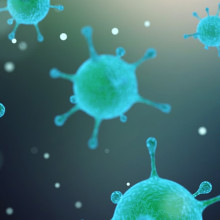
04:14 - Common cold to treat pancreatic cancer
Common cold to treat pancreatic cancer
with Dr Stella Man, Dr Gunnel Halldén - Queen Mary University of London
The long-term survival rates from pancreatic cancer are notoriously grim. Steve Jobs, Patrick Swayze, Alan Rickman and Luciano Pavarotti are well-known recent victims. The prognosis tends to be so dismal because pancreatic tumours usually come to light only at very advanced stages of the disease, and by then the cancer has often also spread elsewhere in the body. Now Stella Man and Gunnel Hallden, from Queen Mary University of London, have found a way to modify a common cold virus to turn it into a form that can be injected safely into the bloodstream, where it selectively infects and destroys pancreatic cancer cells, including those that have spread to other parts of the body. Starting with Gunnel Hallden, Chris Smith heard how it works...
Gunnel - We have a long experience with developing cold viruses, so called adenovirus, into mutated versions of the virus that can only target and kill cancer cells. Our idea was based on targeting pancreatic cancers specifically; and another advantage with adenovirus - the cold virus - is that they can also sensitise cancer cells to the current chemotherapeutic drugs; so you would kill the cancer cell with the virus. You would also help the chemotherapeutic drugs to kill the cancer cells and then you could also re-activate the immune system, so that was the idea behind this.
Chris - So, Stella, what you were effectively trying to do here is to reprogramme what would be a cold virus and be spread by coughs and sneezes, and make it attack cancer cells. What was your approach to doing that? How did you do that?
Stella - In pancreatic cancer cells they have a protein displayed on the outside of these cells that is not displayed on normal cells. So we took advantage of that and we’ve changed the outer coat of the virus so that this virus can now target the cancer cell and not the normal cells. Another modification is that we’ve engineered the virus so that it can enter the normal cells but it won’t do anything. But when it enters into the cancer cell it can replicate and make more copies of itself, and then the virus bursts out of that cancer cell - killing the cell in the process and go on and infect the neighbouring cells.
Chris - So in essence, we have a virus that seeks our actively cancerous cells of the type that you're going for?
Stella - Yes.
Chris - It only grows actively in those cells and then once it’s grown and increased its number it buds out from the infected cells and infects all of the neighbouring cancerous cells if there are any so, in essence, what it’s doing is it’s growing until it runs out of cancer cells to kill and then it will just stop?
Stella - That’s right; that’s the idea behind it. Which is why we needed to also develop it so that it can be delivered via the bloodstream so that you can reach cancer cells that may have already spread away from its original site of growth.
Chris - And Gunnel, when you do this is it safe to inject this virus? Are you sure that it’s capable of targeting exclusively the cancer cells that you think it’s targeting or is it possible it could get into non-cancerous cells and do harm?
Gunnel - We haven’t obviously tried it in clinical trials yet but when we have done animal studies, and in animals it works exactly as Stella just explained. We can inject it in the blood, it will go to the tumour, it will express its genes and start replicating in the cancer cells, but we haven’t found it in any other tissues in the animals so it seems safe.
Chris- And Stella, one of the key things about cancer is it’s a moving target because it’s a genetically unstable entity and it means that it adapts, it evolves, and it becomes resistant to things like chemotherapy drugs. Is there a way in which the cancers could evolve to duck away from your virus so the virus can no longer attach itself to the cancer and get in via the mechanism that you’re relying on at the moment?
Stella - There’s always a possibility. I guess the length of the animal study is not long enough to see that but we didn’t see anything like that in our animal studies, so we haven’t seen any evidence of that.
Chris - It’s sounds very encouraging doesn’t it? Now given that these are cold viruses - adenoviruses - is there not a possibility that someone has experienced exposure to a virus like this before they could be immune to it and, therefore, that would limit its ability to work?
Gunnel - Yeah. It is possible, especially if you give the virus in the blood stream. But from other studies with similar viruses it seems to be possible for the virus to still reach the tumour the first time. Maybe the second time you would have to modify the virus a little bit but it’s not a major problem. Most of the viruses will reach the tumour.
Chris - What’s the next step them? You’ve proved that you can do this in cultured cells, you’ve proved you can do this in a limited way in animals. Animals don’t naturally get pancreatic cancers like we do so there is an inherent limitation to what you can achieve in animals, is the next step then to go into humans?
Gunnel - The next step would be we would like to first investigate a little bit more about the immune response in animals, and then we would go on and study toxicity in larger animals. After that, we would be ready to apply for funding to go into early stage clinical trials.
Chris - You probably get asked this a lot at dinner parties, both of you, but have you seen the film “I am Legend”?
Gunnel - Oh yes!
Stella - Yes!
Chris - Any reactions to that?
Stella - Those movies look very scary don’t they! It makes it look like a disaster zone so we were actually expecting questions like this but, luckily, this virus is not the same type of virus so it doesn’t carry the same risks!

12:02 - Mini robots to transform healthcare
Mini robots to transform healthcare
with Professor Metin Sitti - Max Planck Institute for Intelligent Systems
Scientists have announced this week that they’ve built miniature, soft-bodied robots that can walk, jump and even swim inside living tissues. And while this may sound like the plot for a sci-fi horror film, the researchers behind the breakthrough believe it could transform healthcare. Lewis Thomson reports...
Lewis - In the 1966 film Fantastic Voyage, a submarine crew shrink down to microscopic size and are injected into the body of a scientist to remove a blood clot from his brain. Although far fetched, the film does highlight one of the biggest difficulties in treating medical problems: making sure treatment gets only to where it’s needed. Shrinking scientists is still some way off but could a robot come to the rescue in the meantime?
Metin Sitti, at the Max Planck Institute in Germany thinks so…
Metin - The objective of our research has been to create a new tiny robot that can have many different types of locomotion modalities inside complex environments like our body. And also we wanted to achieve not only navigation capabilities in such a robot, also we wanted to achieve new functions like carrying a cargo and delivering it in the right locations that we want.
Lewis - Resembling a tiny sheet of rubber just a few millimeters long and less than a millimeter thick, the robot the team have come up with looks quite simple but is actually incredibly sophisticated. Made of elastic silicon, the sheet is packed with microscopic magnetic particles which allow the team to use magnetic fields to control the shape of the robot and to make it move…
Metin - The robot is enclosed inside a space where we have outside many electromagnetic coil systems that we designed for medical applications, and these coils can generate uniform magnetic fields that we can change both the direction and also magnitude precisely. Then depending on this magnitude and the direction of the magnetic field, the robot changes its body shape into different deformations, and those deformations are also changed by time. That way it can undulate its body, it can deform in specific ways and then also rotate its body to create all different swimming, and walking, and jumping type of behaviours.
Lewis - The team set up obstacle courses to simulate different areas inside the human body to see how well their robot could cope with different anatomical terrains…
Metin - Our robot has seven different navigation capabilities: we can walk, we can also jump, and we can also crawl inside enclosed cavities like a vascular system or in a tubular system. Then when you get into any region where we have fluids, the robot can navigate on the water surface by skimming through it by undulating, or by climbing on the water’s surface using body shape change. Then next is we can dive under the water and swim like a jellyfish. If you count all of them we have seven capabilities or different conditions where we might have inside our body.
Lewis - The next step for the robot is to venture inside the body controlled by external magnetic sources like those used in MRI machines…
Metin - To get inside our body would enable us to reach areas that we cannot reach without surgery. This tiny robot can be swallowed or injected inside the body, or through a small incision we could put it anywhere inside our body and then we would navigate it using our magnetic control to get them to a target location first. Then using the functional capability of delivering a drug or a cargo, we could deliver a drug in a specific location for medical use that would help us a lot in cancer therapy and many other applications.
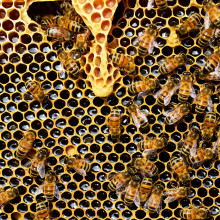
16:12 - Is keeping bees bad news for wild pollinators?
Is keeping bees bad news for wild pollinators?
with Dr Jonas Geldmann - Cambridge University
Who doesn’t like to think of the humble honey bee, buzzing about helpfully pollinating crops and wild plants? Concerns over declines in honeybee populations have resulted in substantial media coverage and a push to up their numbers. But some scientists think that this focus on honey bees could be causing problems for other pollinators. Katie Haylor spoke to one such scientist - Jonas Geldmann from Cambridge University. First, Katie asked why bolstering honey bee populations might mean trouble...
Jonas - Honey bees are, effectively, an agricultural species: we generally have them to produce honey and we have then to pollinate our crops. But when the amount of nectar and pollen from our crops doesn’t match the number of honey bees, they will go and forage in natural habitats in nature all around us, and that can create competition with other pollinator species.
Katie - What kind of other pollinators are we talking about?
Jonas - Primarily bees. But it’s also butterflies, it’s hoverflies that help the natural habitats with the pollination services.
Katie - Do we have an idea of how much responsibility these wild pollinators bear in the terms of the services they provide?
Jonas - I guess there’s two aspects to that: in terms of the actual agriculture where we depend on our honey bees, there are studies that show that as much as 50% of the pollination services could, potentially, be delivered by our wild pollinators, so they could play a major role there. Outside of our crops they could, potentially, be responsible for all of the pollination.
Katie - Okay. So managed honey bees are affecting the resources that are available to these other wild pollinators, is there anything else that we should be concerned about?
Jonas - Honey bees also carry a lot of diseases that they can transmit to wild pollinators simply because they share the same flowers. It’s almost the same as if have a candy bowl on a table that’s sort of equivalent of the flower, and if one person who’s sick eats a bit of candy out of that, the next person who’s going to take some candy is likely to have a higher risk of being sick as well.
Katie - Oh dear.
Jonas - Yeah. I think it’s important to say this potentially is a problem in some of our very resource poor habitats where most of our threatened pollinators are. The biggest problems to pollinators, both the managed honey bee and the wild pollinators is still intensive agriculture it’s pesticides, it’s this simplification of the landscape that leaves less and less wildflowers around for both the honey bees and the wild pollinators to forage on. But, when that’s the case, there will be areas where the wild pollinators will likely be additionally threatened by the fact that there are honey bees.
Katie - What can we do to address this balance?
Jonas - In the areas where we have set aside land for nature and for biodiversity, we probably shouldn’t have honey bees and this probably includes a buffer. Honey bees can forage as much as 10 kilometres away from their hives, generally less, but they can move that far away so it will likely require a buffer. In the areas where that’s not the case I think there’s a need to assess what the actual need is for honey bees. Right now, because there’s a fairly large disconnect between the farmers who need pollination services and the predominantly hobby type of honey bee keepers, there’s no coordination between what actually is the needs for pollinating services from the honey bees and for the number of honey bees, and this is obviously in space but also in time. Many of these agricultural crops are in bloom for a very short period of the year.
Katie - So a more strategic matching of the number of managed honey bees compared to the wild pollinators.
Jonas - Yes
Chris - What is the comparison when one considers the impact of people keeping a few bees - a few million bees - compared with farmers with intensive agricultural methods, pesticides, other kinds of chemicals that are going on those fields, is it not just kind of David and Goliath?
Jonas - It’s another complicated question. In much of western Europe, the United Kingdom including, biodiversity is in a massive crisis. We’re seeing declines of insects way beyond the pollinators and this is likely largely because of an intensive agriculture that both takes up a huge amount of area where there is growing nothing but one single type of crop, they’re clearing out the areas around the fields and they’re using pesticides that kills almost anything that’s on the field and is likely to have an impact outside of the field. This is obviously across almost any organism the biggest problem for nature. But honey bees are an exceptionally effective pollinator and collector of nectar, so in areas where there are absolutely no agriculture but where there are very pristine nature, very valuable nature, and people are putting these honey bee hives in, they are having an impact on the native wild pollinators and they’re having it for no good reason. So I think it is a place that is still worth exploring even though it’s by no means the biggest challenge to nature in the UK or anywhere else in the world really.

21:34 - Does music carry universal meaning?
Does music carry universal meaning?
with Dr Samuel Mehr, Manvir Singh - Harvard University
Music from different cultures can sound extremely different from one other: a Scottish ballad may not have too much in common with an Australian healing song by the sound of it. But is there something intrinsically in music that crosses cultural divides to tell us what the music was originally intended for? Georgia Mills spoke to Samuel Mehr and Manvir Singh from Harvard University...
Samuel - We started by working with a project called the Natural History of Song project. And that’s a project where we’re basically taking modern techniques from the cognitive sciences, from data science, from a few other fields to try and systematically characterise different features of music and musical behaviour from around the world.
So, basically, we took this dataset that we had built for this bigger project which was a systematically built collection of four different kinds of songs from 86 small scale societies around the world. They’re dance songs, lullabies, healing songs and love songs.
We took this sample; we’ve got 118 different songs split across those genres. We randomly selected a very short snippet of each song - 14 seconds long, and then we took all those snippets and we played them to people all over the world. People who lived in 60 different countries and who were recruited on the internet.
All we did is that for each little excerpt that they listened to we asked them a series of questions. We said tell us if you think that the singers definitely do not use the song for such and such or definitely use the song for such and such? In these questions such and such was something like use the song for dancing, or use the song to soothe an infant, or to heal illness? So the question is: can these naive listeners on the internet who’ve never heard these songs, they don’t know anything about these cultures, can they tell what a song is for, what it's function is on on the basis of its musical forms - what’s actually there in the recording?
Manvir - My name is Manvir Singh. I’m a PhD student in human evolutionary biology, also at Harvard University. What we found was that people seemed to be very very good at identifying dance songs. The effect for people rating dance songs as being used for dancing compared to other songs was huge. People are also really good at identifying lullabies. People are okay at identifying healing songs, so there was an effect but that was smaller than the effects that we saw for dance songs and lullabies. Then we found that people are actually not able to identify love songs. Kind of relatedly we also asked two extra questions on the side, so is it used for mourning the dead and is it used for telling a story? Interestingly, people rated healing songs as especially high on the dimension mourning the dead. Although they couldn’t recognise love songs as being used to communicate love, they did rate love songs as especially high on the dimension being used to tell a story, which is kind of interesting finding that maybe has implications for what love songs are and how they do communicate love.
Sam - There was pretty much strong agreement among experts in the field that we were not going to find the things that we did actually find in the study. It was the standard view was music is culturally produced, it doesn't have things in common with one another across cultures. Each culture has their own interesting, unique musical idiom on the world and our study is not saying that that’s wrong. Our study is saying that even though it’s really clear that from culture to culture there’s incredible variation and insane differences in how dance songs are used, and what they sound like, and there’s all sorts of differences. Underlying all of that really interesting variance is the simple fact that these songs are all produced by human minds, and human minds have features in common with on another. Just because there’s a lot of really interesting variance doesn’t necessarily mean that cultures don’t have things in common with one another.
Manvir - We definitely don’t know from our study why there are dance songs and why there are lullabies. But one thing we do know is that people around the world respond to a certain string of musical stimuli in a similar way. People around the world have minds that when they hear some certain kind of stimulus they want to dance, they want to move their body. And, similarly, people around the world have minds that respond to a very very different kind of sound by being calmed and falling asleep. Why humans have those minds is an open question, but our study at least kind of pushes us forward in showing us that we do seem to have those minds. Kind of relatedly, and much more weird, people seem to have minds that in response to certain kinds of musical stimuli seem to think they’re being healed spiritually, which is more more bizarre and fun question.
Song information - in order of appearance:
- Love song, Scottish Highlands, 1953
- Love song, Q'ero Quichua - Central Andes, 1964
- Dance song, Chuuk - Micronesia, 1984
- Love song, Rwanda, 1952
- Healing song, Otavalo Quichua - Central Andes, <1960
- Lullaby, Nyangatom - Eastern Africa, 2012

27:54 - Altruism: would you risk your life for a stranger?
Altruism: would you risk your life for a stranger?
with Lewis Thomson - The Naked Scientists
What actually is altruism? Lewis Thomson tells of one remarkable example of this behaviour...
On the 2nd January, 2007, construction worker Wesley Autrey was standing on a subway platform waiting with his two daughters for the train to arrive. Beside them a young man began to have a seizure and fell onto the tracks with a train fast approaching. Autrey realising there wasn’t enough time to pull him up jumped down onto the tracks and lay on top of the man pinning him to the ground to stop him flailing. Amazingly, the train passed over them missing Autrey by just an inch.
This is just one of many examples of instances when an individual has risked their own life to save someone else. And although this may seem like a very human thing to do, altruism - sacrificing something of yours for the good of another individual - is a behaviour found in many species. Individuals will give up their food, breeding rights, even lives to help others survive.
But if evolution is all about the survival of the fittest, how do behaviours like this evolve?
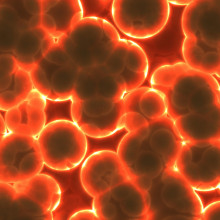
29:04 - Good bacteria: can microbes be altruistic?
Good bacteria: can microbes be altruistic?
with Professor George Salmond - Cambridge University
Surprisingly, even some of the smallest organisms on Earth are capable of altruism. George Salmond, from the University of Cambridge, studies altruism among bacteria and he spoke with Chris Smith. First, Chris asked George about the circumstances in which bacteria can be altruistic....
George - Bacteria, like every other living organism on the planet are susceptible to virus infection. For bacteria these are called bacteriophages, or bacterial viruses, and these viruses only attack bacteria. The virus adsorbs to the bacteria, injects its genetic material, and essentially turns the bacterial cell into a factory for virus production. Then generally, these infected cells burst open to release lots of new virus which then goes on to infect other bacteria in the population.
So if you’re a bacterium, there’s a whole series of different strategies that have evolved to resist the potentially lethal effects of viral infection. And the one that we have found - the bacteria appear to commit suicide after viral infection. This superficially doesn’t seem like a clever strategy but, actually, that leads to the termination of replication of any invading virus and that means there’s no release of any new virus, and that means the rest of the bacterial population are protected from subsequent viral infection.
Chris - The bacteria are essentially putting themselves into isolation, albeit terminally, in order to prevent the spread of that infection through their population. How do they know they’ve been infected?
George - That’s a very good question. We know that only certain bacterial viruses can induce this system - it’s called abortive infection and essentially they must be titrating a particular viral signal, which we are currently trying to investigate. In their cells they have a thing called a toxin-antitoxin system and somehow the viral product seems to stimulate or destabilise this toxin-antitoxin system which leads to the killing of the bacterial cell - the suicidal event.
Chris - I suppose you could think of it a bit like a seesaw where you’ve got a balance. There’s this toxin trying to tell the cell to die, an antitoxin telling it to stay alive and when the virus comes along it adds weight to the end of the seesaw that says “die.” And that triggers the cell to then say well, I must wipe myself out because if I allow this virus to replicate in me I’m going to then infect the rest of my population. What’s the benefit to the population as a whole of that bacterium surrendering itself?
George - You need to think of bacterial populations, of course, as clonal.
Chris - What does that mean?
George - They’re all identical in a population.
Chris - Genetically because they’re splitting, so when one becomes two, becomes four, becomes eight, and so on it’s just because the cells are dividing, so they’re sharing exactly the same genetic information?
George - That’s right. They’re identical in that sense. So you can view that if one cell gets infected by a virus and give up it’s life then, essentially, it’s protecting the rest of the clones in that population.
Chris - So the genes survive because the same genes are running in that entire group of bacteria, but the individual cell that got infected has wiped itself out but it doesn’t really care because the genes are being propagated?
George - Absolutely.
Chris - How do you think that this behaviour evolves in the first place because that’s pretty complicated that they’ve been able to do that?
George - The system we’ve been investigating, we don’t know that that system is titrating the availability of virus infection in every case. We think that there maybe other environmental signals that also can stimulate this suicidal event, for example, nutritional stress.
Chris - So the bacteria, if they’re going hungry they could, for instance, think well, if I wipe myself out some of my friends may still make it?
George - That may be one strategy, yeah.
Chris - Are you saying that the same sort of system could be co-opted in response to lots of different stresses and pressures that the bacteria could just ultimately use this to minimise the number of viable organisms, therefore minimise the demand on the food supply that maximise the chances that strain or species will survive?
George - That may be happening in some cases. This is quite a complicated area because the amount of information on the mechanisms involved there’s a paucity of information there. But in our case, studying viral replication, it’s very clear that the population survives in the presence of the virus.
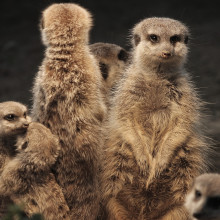
33:29 - Community-minded meerkats
Community-minded meerkats
with Professor Tim Clutton-Brock - Cambridge University
Does it pay for animals to act altruistically? One species with a particularly strong community-spirit is the meerkat. To find out more about why meerkats help each other out, rather than just fend for themselves, Lewis Thomson and Katie Haylor met up with one human expert, and many excitable meerkats...
Tim - Hello, I’m Tim Clutton-Brock. I’m a zoologist at the University of Cambridge and I work principally on Kalahari Meerkats and we work in a site in the southern Kalahari just on the South African-Botswana border.
Lewis - We’re not in the Kalahari right now. We have come to the Animal Experience in Cambridgeshire and we’re surrounded by about five meerkats I think. They’re all running around. Shall we go in and sit down and get a bit closer to them?
Tim - Fine.
Lewis - They’re climbing over Tim’s shoe at the moment. I’m not sure if he thinks it’s food. No… don’t go for the microphone cable.
Tim - I’ve got a meerkat on me.
Lewis - He wants to be interviewed.
Tim - He wants to smell my mouth too closely I think. The unusual thing about meerkats is that they’re one of the most cooperative animals in the world and for evolutionary biologists cooperation poses a problem. It’s not difficult to understand why animals compete with each other because they’re competing for food and breeding opportunities and so on. But meerkats, like a number of social insects, spend much of their time helping other individuals to breed rather than breeding themselves.
Groups typically consist of one breeding male and one breeding female, and then a variable number of individuals, sometimes 20 or 30 individuals, many of them fully mature who spend a large part of their lives helping to rear offspring born to the breeding female. They enjoy eating people’s ears…
Tim - Eventually the meerkats decided that our producer’s ears weren’t really worth eating. Back to Tim…
Tim - Cooperation on this level is unusual in mammals. Meerkats have a complex system of helping so that when the dominant female is producing pups, other individuals clear out the burrow, and some of the non-breeding females will lactate to the young of the breeding female. When the group leaves the breeding burrow in the morning to go foraging and the breeding female goes with them, one of the helpers will stay and protect the young for the rest of the day with a result that they will spend a full 24 hours without getting any food.
Then once the pups start to move with the group and forage, which they do at about three weeks after they’re born, the members of the group go and collect food and they bring it to the pups. Most of the members of the group give away around half of all the food they find to the pups and they do that for the first three to four months of pup life. When the groups foraging, it’s commonly the case that one individual stops feeding, goes up on raised guard and looks for predators, and gives alarm calls if it sees predators.
Lewis - This raised guard is that classic image of meerkats standing up like footballers defending a free kick. They’re ready to alert their troup to any eagles, snakes, or jackals… So why put their neck on the line like this?
Tim - The only animals that live in cooperative systems like this are animals where all the group members are closely related because most of them in a meerkat group, most of the individuals are full siblings. So they’re helping to rear individuals that are 50% related to them which is the same level of relatedness as their offspring would be if they produced offspring themselves. If their parents are much more likely to be able to produce and rear offspring than they would themselves, another way of breeding, if you like, is to help their parents produce further siblings rather than trying to breed themselves.
Lewis - But why does being closely related, that is having a similar genetic makeup or genotype matter?
Tim - Well, if you put it in the simplest way, animals are selected to maximise the proliferation of their genotype in future generations. So, if you’re helping to rear individuals that are 50% related to you, you’re extending the proliferation of your genotype into future generations just as you are if you breed yourself. If, on the other hand, you’re helping an individual that’s only 5% related to you, you are making very little contribution by that to the proliferation of your genes into future generations.
Lewis - Do you think altruism is an appropriate term to use when we’re talking about meerkat behaviour?
Tim - Well, it all depends what you mean by altruism. These individuals are helping other individuals breed, but that for them is the best way of ensuring the proliferation of their genotype. So there’s a real evolutionary benefit to these individuals, but they certainly are helping other individuals at some cost to themselves so, in the technical sense yes, I call that altruism.

39:03 - You scratch my back, I'll scratch yours
You scratch my back, I'll scratch yours
with Dr Claudia Wascher - Anglia Ruskin University
Why do individuals make sacrifices for others that they're not related to? Chris Smith went for a wander along the banks of the River Cam with Anglia Ruskin University’s Claudia Wascher to hear about “reciprocal altruism”...
Claudia - Reciprocal altruism means that one individual show behaviour which is costly for the individual showing the behaviour however, this behaviour benefits another individual. One example would be alarm calling: if one individual gives an alarm call this is actually costly for the individual because it might attract the predator to itself but it might benefit individuals in the surrounding. Usually those individuals are not related so we cannot say that it’s benefitting related individuals but it’s unrelated individuals.
Chris - It’s like if I saw someone creeping up on you and they’re going to push you in the river over there and I shouted out Claudia be careful there’s someone going to chuck you in the river, they could come and push me in the river, so I’m doing you a service but I’m also taking a risk myself? So why is it reciprocal then?
Claudia - Because it is repeated in directions. Usually it is individuals showing this behaviour to warn other individuals who will help back in the future.
Chris - So I’m helping you with the expectation that when the tables are turned and you see someone about to push me in the river, you’re then hopefully going to warn me?
Claudia - Yes, exactly.
Chris - What other tangible examples are there of this happening then in nature?
Claudi - In primates, for example, your would see individuals grooming each other reciprocally so this can be measured up to the minute sometimes. One individual will groom another one for five minutes and would get exactly the five minutes back.
There is the alarm calling examples, so individuals warn other individuals. This is especially the case in territorial bird species for example. Here territory neighbours would get familiar to each other so they know each other and they would be reciprocal in attacking predators who enter the territories. Another example is food sharing. The vampire bats share food with other individuals in a reciprocal manner.
Chris - What do they share a jugular vein or something?
Claudia - Kind of. They are quite dependent on finding blood every day because otherwise they would starve to death. After they have been foraging they would then meet in caves and then sometimes there are individuals who haven't found prey during the day and other individuals would give them blood.
Chris - That’s jolly generous of them. What’s to stop someone cheating the system though because I could rely on you warning me I’m about to go in that river, but I might not return the favour? So how has it evolved do you think that actually we do scratch each other’s backs?
Claudia - As reciprocal altruism is depending on repeated indirections individuals would just stop at some point. If I see that I am giving you things like I’m grooming you or that I’m giving you food and I don’t get anything back from you, I will just stop the interaction. This is a situation where we have inequity aversion which is behaviour that individuals would respond negatively to a situation where they’re treated unequal.
For example, primates have been trained to exchange a piece of food with a human experimenter for another piece of food. In this experimental situation two primates have been tested with the human and one of the primates would get a grape for exchanging, and the other would get a cucumber and they like the grapes much more than the cucumber. So, at some point, the monkeys receiving the cucumbers actually stopped the interaction, stopped their behaviour, they stopped exchanging because they didn't like to be treated unfair. It went to a point that this monkey being treated unfair would even throw the cucumber at the human experimenter etc to really show that they really didn't like this behaviour.
Chris - That’s quite high level cognition though, isn’t it, for me to be able to tell whether you’re giving me a bad deal or not, I have to put myself in your shoes and ask what would you do to me and visa versa? So does that limit what sorts of species are capable of this sort of behaviour?
Claudia - Yes, definitely. Reciprocal altruism has been suggested as the form of cooperation which takes the most advanced cognition. There are certain cognitive prerequisites individuals need to have to engage in reciprocal altruism. One of these is inequity aversion, they need to be able to estimate what are the costs for me; what am I getting out of the interaction?
The second thing they need to know is they need to recognise individuals. They need to recognise their cooperation partners and to memorise them, which sound trivial, but it’s not as trivial for non-human animals.
The third thing is that individuals also need to be able to cope with the delay of gratification, because if I’m doing something which is costly for me now and I only get back the benefits somewhere in the future, I need to be able to cope with this delay. Which, again, sounds very trivial but we also know, even from humans that there is this is very very difficult for humans. When somebody tells you you can have this piece of cake now or you wait and you will get two pieces somewhere in the future, you’ll probably say I won’t wait I’ll just take this piece now.
Chris - But some people do have their cake and eat it straight away don’t they? Why do you thin this evolved in the first place?
Claudia - My guess would be that complex societies make it necessary. If you live in a complex society of unrelated individuals you probably need to cooperate with each other in order to achieve a common aim. It’s likely that if you repeatedly interacting with non-related individuals, a system like this evolves.
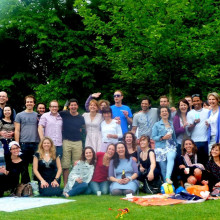
45:16 - Altruism in humans - what makes us special?
Altruism in humans - what makes us special?
with Dr Sander van der Linden - Cambridge University
Microorganisms, meerkats, and monkeys - they all behave altruistically for different reasons - but what about us humans? Is there anything unique among us humans when it comes to altruistic behaviour? Katie Haylor spoke to Sander van der Linden, from Cambridge University....
Sander - I think when it comes to human altruism there is a defining feature. Whereas in biology it’s about increasing the fitness of an organism at the expense of your own fitness, so your own potential to reproduce genetically. With humans it’s all about psychological motivations that we have to disentangle, so what are the motivations for helping someone else? And I think that poses a fundamental problem to try and figure out how altruistic we are exactly in different situations.
Katie - How do we explain the random acts of kindness, the good samaritan? Say Wesley Autrey we heard about before who dived in front of a train to help that person he didn’t know, how do we explain that?
Sander - Yeah, that’s a great question. We’ve heard about kin selection: sometimes we help other people because they’re just genetically related. We’ve heard about reciprocal altruism: scratch my back, I’ll scratch yours. But what about those cases where you’re not going to interact with a stranger ever again, why would you be incentivised to help that person?
I’d like to split that out into two motives: an individual motive which is that a lot of research shows that people derive positive internal benefits when helping other people. When we help other people the heart rate tends to go down, our blood pressure tends to go down and it can have positive impacts on depression. When you put people in neuroimaging scans it shows that the reward centre of the brain lights up in certain situations. Economists refer to this as ‘warm glow,’ and so the idea is that people derive pleasant emotional experiences from helping other people.
The other is more social that we care as a group-living species we care about our image. You see this in primates too, but especially in humans we care about our reputation. We want to be seen as a cooperative individual who’s going to help and benefit the group. That we’re going to essentially do our bit because that’s an adaptive advantage to have as a group member. This is called image motivation.
Chris - Is this inherited or learned?
Sander - Another great question. We learn about norms in our societies. To some extent this evolves but, on a more simpler level, we acquire norms through social learning. If it’s the norm to help other people, we learn that from other people. Sometimes norms are institutionalised and they get passed over from decade to decade, and even if you talk about cultural evolution over larger time periods. but there’s a lot of variation in culture. The extent to which culture replicates like a gene is a bit more complex but, certainly, we inherit rules and rules of thumb and norms from observing other people.
Katie - This notion of it feels good to do good deeds, does the dopamine reward system come into play here?
Sander - Yeah. Some studies show dopaminergic pathways are activated when people think about donating, for example, or helping other people, and so these ‘feel good’ neurotransmitters are released. Sometimes it’s a bit difficult to disentangle because there’s always other factors that can activate similar neural substrates, and so it’s always a bit difficult to tease out causality but, generally, those factors are associated with helping other people.
Katie - Could the notion of being nice to strangers, could this idea have evolved as a byproduct of it being beneficial to be nice to your friends or your peer group?
Sander - I think it’s difficult to tease out basic mechanisms such as the ability to experience pleasure which is not necessarily related to altruism, even though those mechanisms are associated with, for example, helping other people. Those mechanisms didn’t necessarily evolve solely for that purpose. I think that is difficult to say but, generally, helping other people is adaptive. In a group-living species it’s extremely adaptive if groups are able to cooperate because then they can outperform groups that don’t cooperate, so the fact that these behaviours are adaptive to some extent. I’d like to think, at least, that people on some level recognise that helping other people is adaptive and that that is the reason why it makes us feel good in the end. But, of course, the ultimate answer to that remains somewhat of a mystery.
Katie - If helping others makes us feel good, is there such a thing as a good deed if we’re getting something from it?
Sander - This is one of the questions I always ask my students because this is essentially a game. I can reduce any behaviour to an egoistic motive. If it makes you feel good it disqualifies as true pure altruism. So if you jump in front of a train to help somebody else, if you experience the slightest amount of ‘warm glow’ in that act theoretically it could disqualify as pure altruism. But I think that’s not the key factor because it seems that it would be unrealistic for us to be so altruistic all of the time. I think if we help other people and we feel good about it and there’s a mutual benefit, maybe we should be satisfied with that.
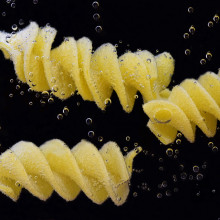
50:36 - Why does fresh pasta rise during cooking?
Why does fresh pasta rise during cooking?
Lewis Thomson put this question to Dr Christopher Brock, senior lecturer in food sciences at London South Bank University…
Christopher - The main ingredients of fresh pasta are water, eggs and durum wheat semolina which is the same material as wheat flour but it has a coarser texture. The wheat contains starch which, in raw pasta dough, is in the form of tiny granules each one just a few hundredths of millimetre across. The properties of the granules as a material are similar to microscopic beads of glass and they’re denser than water. This is why fresh, uncooked pasta like gnocchi sinks to the bottom of the pan.
Lewis - So what happens when you cook it? What makes the pasta rise?
Christopher - Well, starch is actually made up of two different carbohydrate molecules joined together - amylose and amylopectin. When pasta is cooked and it reaches about 60 degrees C, the starch granules absorb water and swell and this causes the amylose to contact and attach to the amylose from neighbouring starch granules. Imagine, if you will, the way that the wax in a lava lamp is exuded and merges with other globules of wax - it’s a similar process. Eventually, the starch is converted into a gel pervading throughout the cooked pasta. This gel contains more water and is less dense than the starch granules in raw dough. However, it’s still too dense to make the pasta rise to the surface of the water.
Lewis - Okay. So heating up the pasta makes it absorb water and lose density, but not enough to make it rise to the surface. What else is going on?
Christopher - This is where the egg comes into play. It is rich in emulsifiers which trap air inside the dough while it is being mixed and kneaded. The air remains in the cooked pasta making it more buoyant, and it’s the combined effect of the reduction in density as the starch becomes a gel and the buoyancy of the trapped air that makes the fresh pasta rise to the surface. Additional buoyancy may result from convection currents and steam filled bubbles rising from the bottom of the saucepan during cooking and pushing the pasta up towards the surface.
Lewis - But why doesn’t dried pasta rise to the surface in the same way?
Christopher - Dried pasta usually doesn’t contain egg so it contains less trapped air. When you cook dried pasta, the starch granules absorb water just like when cooking fresh pasta but this isn’t enough to make the pasta rise to the surface.
Lewis - Thanks Chris. Next time we’ll be tackling Trent’s temperature question:
The temperature where I live recently hit -40 degrees, and got me thinking, is it better to walk or to run through the cold air? Should you run to reduce the amount of time out in the cold or do the adverse effects of moving faster, like windchill, outweigh the benefits of getting to your destination quickly?










Comments
Add a comment